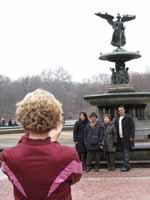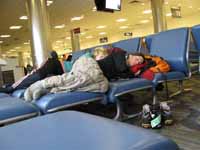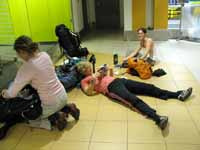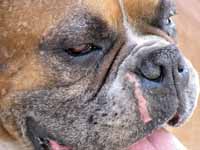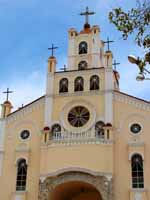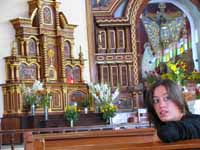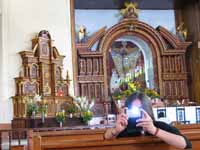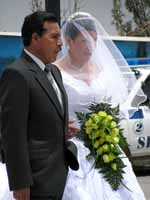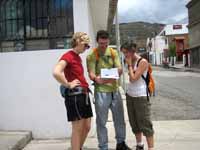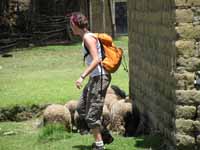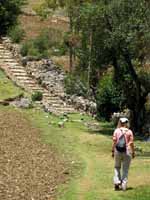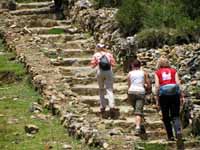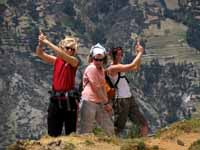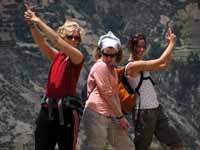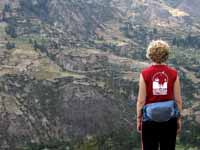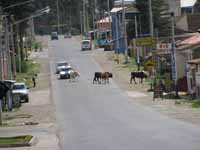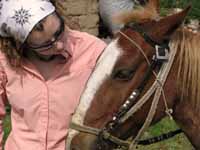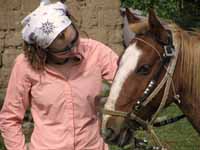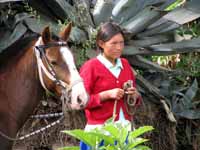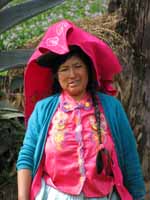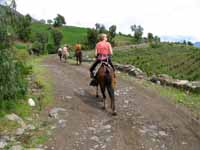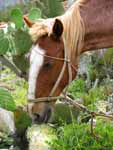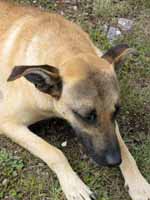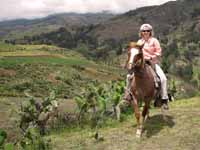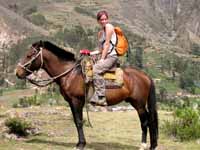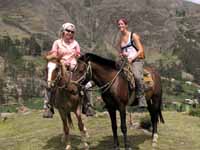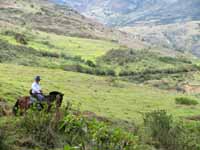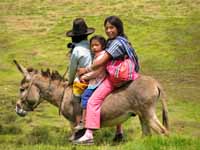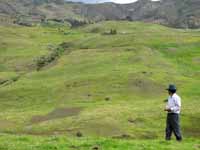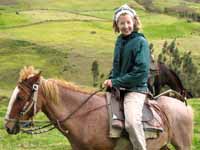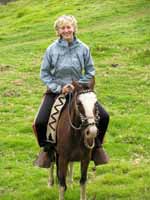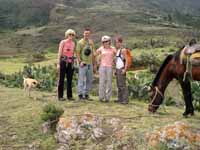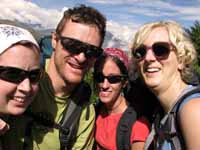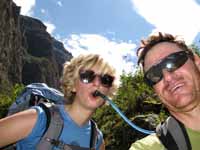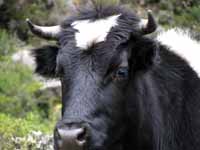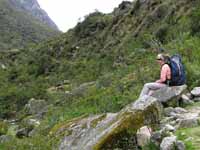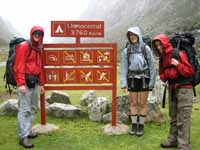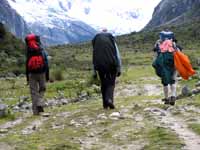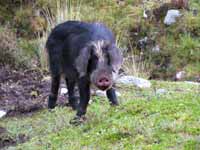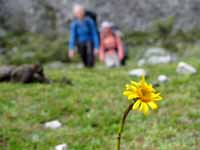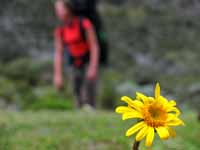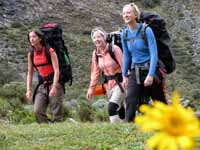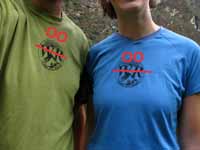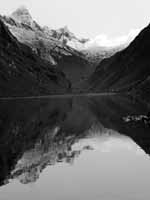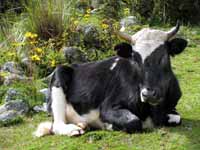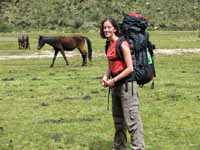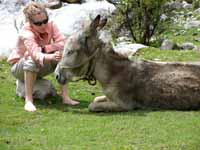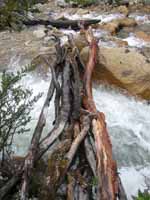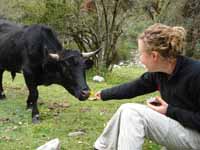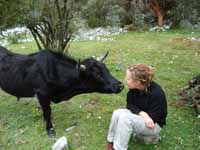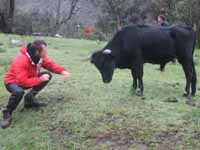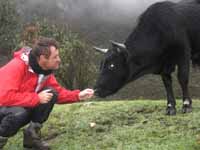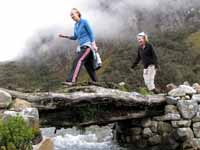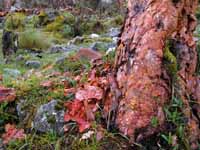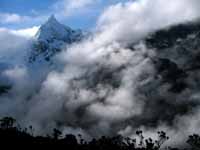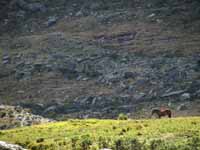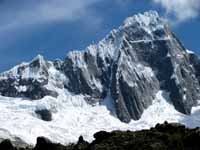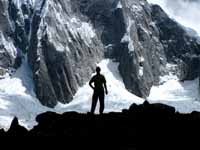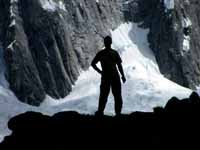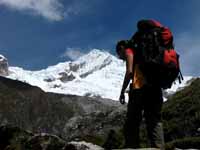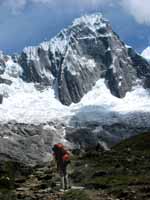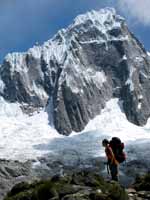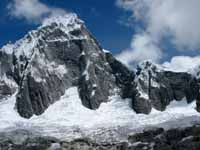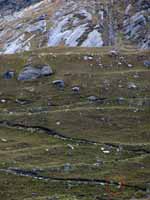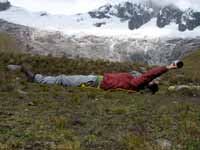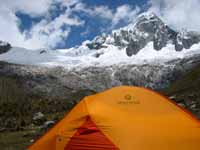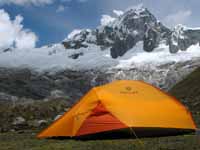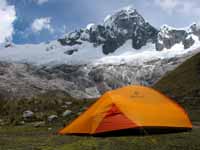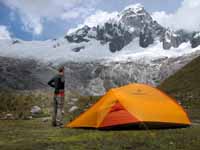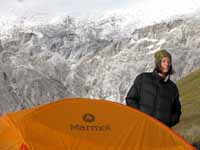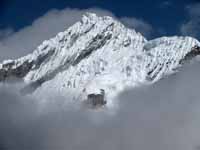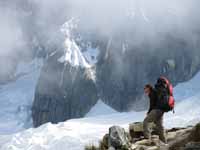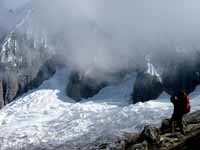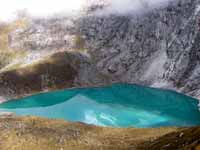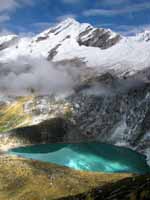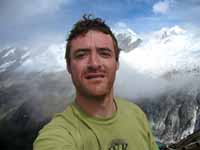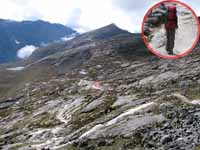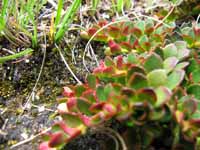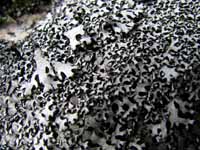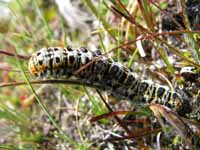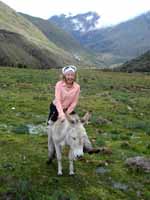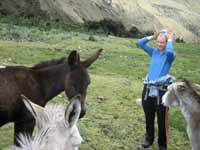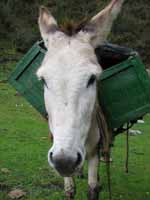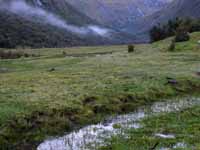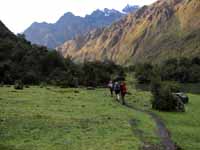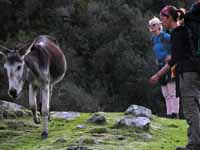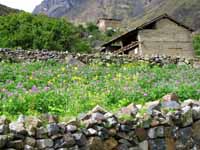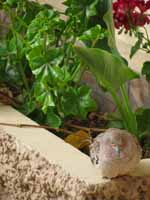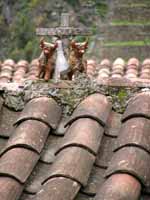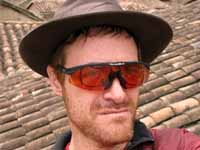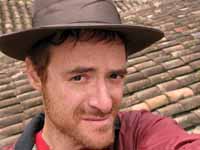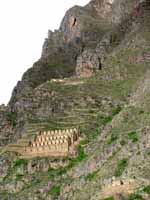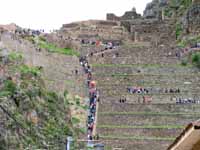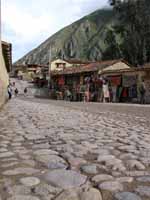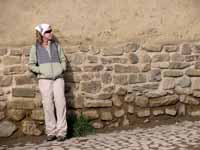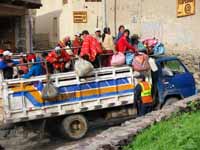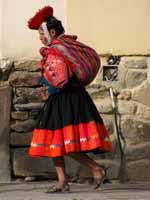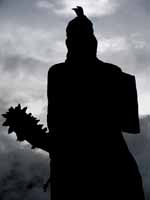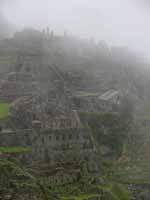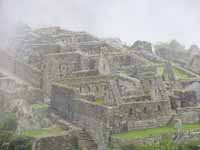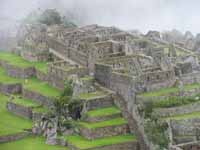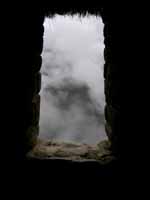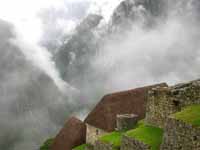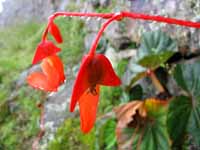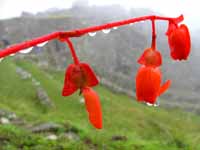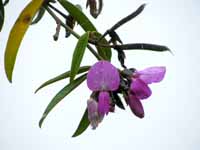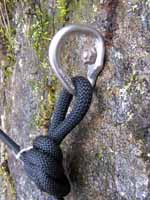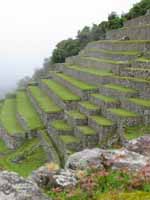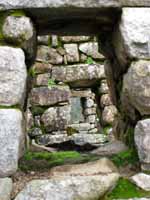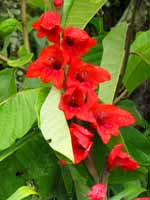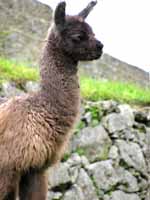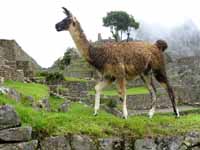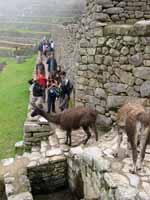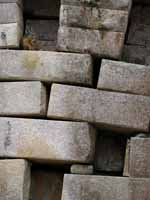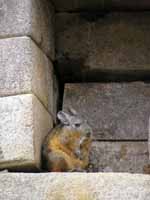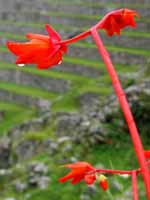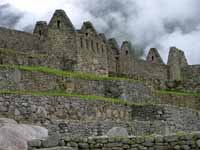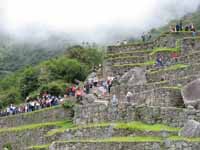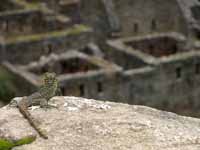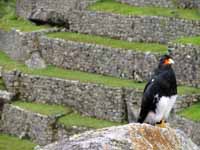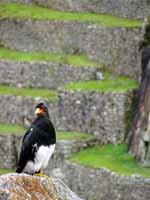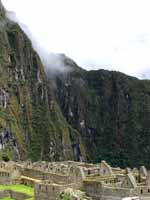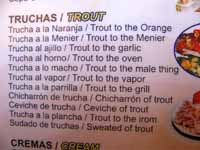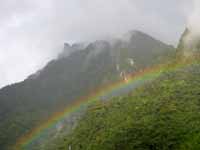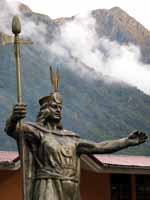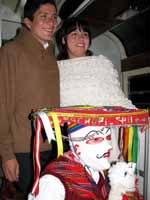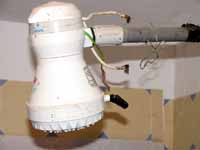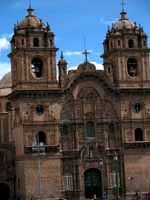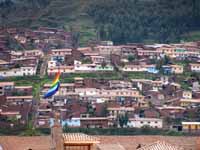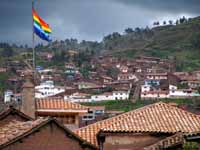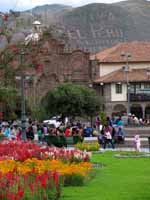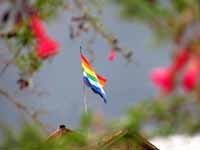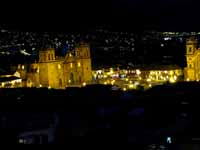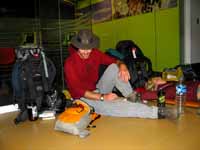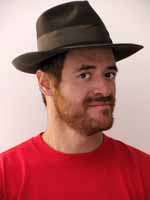Travel --- 12/26/2008 - 1/17/2009 --- Peru
12/26 Take the very expensive short line bus to NYC. Coincidentally, Brett has a shoulder injury. We compare slings.
12/27 Emily arrives early in the morning. Along with Brett, we take a long walk through Central
Park, stopping for a while at Belvedere castle, and finishing at a very crowded
5th Avenue. Then we head to the International Center of Photography to see
the exhibits. The main exhibit is of Cornell Capa, who did quite
impressive work though he was far overshadowed as a photographer by his brother,
Robert (I can relate). There are also exhibits of Eugene Smith's work and
tintype photos. 12/28 Emily and I leave at 4:30am to catch our flight. We meet a
very amusing drunk in the subway. He is distressed that the woman he just
met sent him home instead of letting him spend the night. More than
anything, he wants us to agree with his view that she did the wrong thing.
We are noncommittal on the subject. We fly to Atlanta where we meet Jen
and Beth. The four of us fly to Lima. 12/29 Arriving in Lima early in the morning we do our best to get
cheap plane tickets to Cusco. Ideally we would like to go to Cusco immediately,
but those tickets are $400 round trip. We find tickets for $175 at the end
of our time in Peru. That will do. At this point we are all exhausted,
but we have more traveling to do. At 5am we take a taxi to one of the bus
stations. Max, our driver, is a pretty cool character. My first
chance at having a Spanish conversation. We talk about Peru, religion,
politics and traveling. I'm happy with my Spanglish and my ability to
communicate. We reach the first bus station and find nothing going to
Huaraz until 11pm. It is low season and many bus companies run a limited
schedule. So Max drives us to Movil Tours where we get the last four seats
on an 8am bus to Huaraz. We sit in the nasty, rat infested (literally) bus
terminal until 9am when our bus finally leaves. The S/45 (S/3 = $1) seats
are comfortable and we all sleep soundly for the entire 8 hour bus ride. In
Huaraz, we wander lost because our map shows the wrong location for the Movil
Tours terminal. Finally, we find hostel Tany where we get a room for S/50
and crash for the night.
12/30 We spend a few hours wandering around Huaraz to get our
bearings. We locate La Casa de Zarela, which is highly recommended in our
guide book, and we decide to upgrade from Tany. Our room is S/80 per night
and we have access to a nice kitchen and 24x7 hot water. The hostel also
has free internet, which is convenient. Internet access is as cheap as S/1
per hour a block down the street. I think it was S/15 per hour in the Lima
airport and S/3 per hour in Aguas Calientes -- basically varying between cheap
and really cheap. Other than two facebook status updates and an attempt at
buying train tickets online, I never use the internet while in Peru. But
it is an easy way to stay in touch... much cheaper and easier than trying to use
the phone. We research activities for tomorrow. Beth reads about a
nearby archeological site and tells us that, "They built these really cool ruins underground."
I question the logic of building ruins. We eat dinner at Patrick's
Creperie, my favorite restaurant in Peru. Local food is basically chicken
and rice, which isn't exactly vegetarian friendly. And we have to be
careful to eat only at restaurants with a reputation for thoroughly cooking food
and rinsing salads in purified water. According to Krystoff -- a fellow
guest at Zarela who was formerly a chef in Huaraz -- restaurants owned by
foreigners are our best bet for food safety. So we aren't getting much
Peruvian food, but at least we eat plenty of quinoa! 12/31 We visit
the ruins at Willkawain which date from 1100BCE to 700BCE. We get a nice tour
from Alex. Then we hike to Monterrey and walk the road back to
Huaraz. About 15km for the day, our first acclimatization hike.
1/1 Happy New Year! Folks in Huaraz really like to shoot fireworks.
This isn't just at midnight. It goes on for at least an hour. We spend
the day preparing for our hike and making reservations to ride horses.
Backpacking meals are pretty easy to put together, especially because we brought
clif bars and some dehydrated veggies from the states. But even just using
the local market it would have been no problem. More difficult is finding
a map. There is no good Peruvian topo. Only the very expensive
(S/80) Austrian Alpine Club map is available. I pay the money because a
good map is worth having. Also worth having is white gas to power my
stove. This turns into another opportunity to use my Spanish. I go
to every hardware store (ferreteria) in Huaraz looking for white gas (bencina).
Nobody has it, but everybody thinks the hardware store across the street will
sell it. Finally I find a liter only to discover that I have no money...
argh! Ok, after much effort, I purchase white gas. Emily and I
filter it through a coffee filter because I'm worried about the quality.
Even so, during our hike we have to replace the Dragonfly's fuel filter every
two meals. Ironically, it turns out that the map and white gas are for sale
back at Zarela. We go to the big market and see everything for sale, including guinea
pigs (skinned and ready to cook). Heading back to Zarela, we play cards
and pigs. We play cards almost every day in Peru, but this is the only
night we play pigs. Not sure why... I really like pigs. 1/2
Horseback riding! In the evening we pack for our five day hike.
Everything non-essential we leave in Zarela's locked storage room. 1/3
Awake early to take the collectivo to Caraz and
from there a taxi to Cashapampa. This is the start of the Santa Cruz
trail. We pay S/10 each for what we mistakenly think are park
passes. It turns out that this is just a small extortion at the start of
the trail and will be greatly exceeded by the large extortion at the end of the
trail. Because of all the traveling, we don't start hiking until 9am. As
a result, it is raining heavily (like it does every single afternoon) by the
time we reach Llamacorral, our first campsite. My shoulder holds up fairly
well. I'm able to carry my backpack and even carry my share of the group
gear. It is sore each evening, but nothing a bit of anti-inflammatory meds
can't solve. 1/4 Awake at 5am so we
can hike before the afternoon rains start. We hike to Quishuar, at the
turn off to the Alpamayo trail. During the day, I put on my sunglasses and
put my regular glasses in the sunglasses case. This turns out to be a
tragic mistake. The case has a gap at the top which isn't large enough for
the sunglasses to slip out, but apparently is large enough for my regular
glasses to slip out. I spend the rest of the trip wearing my prescription
sunglasses. This isn't a problem during the day, but at night I've got the
choice of being blinded by sunglasses or blinded by my terrible vision. 1/5
We start the day with a quick hike to Alpamayo. It is supposed to be one
of the most beautiful mountains in the world. We mostly see clouds.
Still a nice hike. We pack camp and split into two groups. Beth and
Emily will go over Punta Union pass today. Jen and I will camp just shy of
the pass. We make camp by 11:30am and I have the whole day to take
pictures of Taulliraju, which is also one of the most beautiful mountains in the
world. For me this is the highlight of three weeks in Peru. Camping at
15,100' it is fairly chilly, though I survive in my 40F bag (which is good down
to about 28F if I wear a layer or two). It is also tricky to cook dinner
since water boils around 188F. But I'm not complaining, it is one of the
most spectacular campsites of my life. 1/6 Jen and I hike over Punta
Union (where I reach my lifetime high point of 15,617') and down to Paria camp
where we meet Beth and Emily. Like every other square foot of the Santa
Cruz trail, Paria is covered in donkey, cow and horse poop. At the start
of the hike conversations would go like this:
By the end of the hike, conversations would go like this: And on top of all that, the poo can be misleading.
1/7 Beth spends the morning collecting the remnants of her food
bag. A cow broke into her vestibule and took everything. Hikers
should bring cow canisters. We hike out to Vaqueria and pay the very expensive
park fee. S/65 per person! That's real money. And they charge
when you exit the park, which means you had better bring plenty of cash for the
entire hike. After much arguing, Beth turns on the tears and gets us out
of buying one ticket. So we still paid the equivalent of $75 in total park
fees for five days of hiking. In the park's defense, the fees are clearly
listed in our guidebook and I like to think that the money is used to support
the park (though I suspect that isn't the case). We wait for a few hours to
catch the collectivo to Yungay. This is an amazing ride in an overloaded
minivan on twisty dirt roads which climb and drop over thousands of feet of
elevation and hundreds of switchbacks. At one switchback we see a
collection of crosses, presumably where a collectivo didn't negotiate the
turn. Luckily we survive the trip and reach the main entrance to the
park. Here officials check our park tickets. Jen and I manage to
pass one ticket between us, so the four of us get by with only three
tickets. This slight of hand greatly amuses our fellow passengers.
We have made friends during the 2.5 hour ride down the mountains and they are on
our side, especially when they hear how much the tickets cost. Of course,
only the four of us are checked for tickets. The other 18 people on the
collectivo appear to be Peruvian and officials let them pass without a second
glance. From Yungay we grab a collectivo back to Huaraz. We return to
Zarela and take much needed showers. Then off to Patrick's Creperie to
gorge on ridiculous amounts of food topped by a chocolate fondue dessert.
Since it is raining, we decide to pay S/3 for a taxi back to Zarela. After
one block our taxi is pulled over by the police and the driver detained for
questioning. We never really know what is going on, but we get out of the
taxi and walk back to our hostel -- the rain no longer seems like such a big
deal. 1/8 Rest day in Huaraz. Most interesting story of the
trip: Beth, Emily and I go to the market in the afternoon. Jen stays
behind to read. When we get back, she tells us that someone came into our
room's entryway and closed the door behind him. This person waited a
moment, then walked into the room. Here he saw Jen, said something about
being in the wrong room and made a quick exit. To me it is clearly obvious
that he is a thief. We have started to get careless with our belongings and
this is a good reminder to take sensible precautions. And it turns out he
is a thief. He has stolen copies of all the room keys from the main office
and gone room to room taking valuables. The police come to the hostel and
Jen is shown pictures to identify the person she saw. I feel bad for
David, the manager at Zarela. He is a really nice guy and the hostel is
great. David has the locks changed the next morning. Even with the
theft, I really like Zarela and wouldn't hesitate to return. 1/9 Our
second long travel day of the trip. We take a bus back to Lima. S/55
for seats that recline most of the way to horizontal. And they feed us a bit,
which saves time because the bus doesn't have to stop for people to
eat. Back in Lima, we take a taxi to the airport arriving around midnight. 1/10
We hang out in the airport until our 6am flight to Cusco. Once in
Cusco, we head to the train office to buy tickets for the Ollantaytambo to Aguas
Calientes train. We had tried to buy them online, but the credit card
verification process failed. Interestingly, it fails again when we are
in the ticket office and we have to pay with cash ($75 per person, round
trip). We are rarely able to use credit cards at any time in Peru.
Luckily ATMs are everywhere. Next we are off to the Instituto Nacional de
Cultura to buy Machu Picchu tickets. The girls are able to get student
tickets (S/62) even though their Cornell ids do not have expiration dates (it
takes some arguing). Nobody is believing that I'm a student, I pay
full price (S/124). Finally, we get a taxi to Ollantaytambo. I spend
the 1.5 hour drive talking to Eric, our driver. He even teaches me some
Quechua. Like about 8% of the population, Eric's mother speaks only
Quechua. He is fluent in Quechua and Spanish, and speaks some
English. Considering my very limited Spanish, I'm happy with how well I am
able to converse with people. I'm always able to communicate the
essentials, and occasionally able to have a social conversation. In
Ollantaytambo we quickly find a quirky hostel (S/75 per night) and crash. 1/11
The earliest train tickets we could get are for the 12th, so we have a day to
kill in Ollantaytambo. The local ruins are very expensive (S/70 per
person) so we opt out. Our hostel has a leaky roof, stinkier than usual
bathrooms and no hot water (which turns out to be due to a power failure in the
whole town). So we move to a different hostel (S/80 per night), which at
least doesn't have a leaky roof. We discover Hearts Cafe on the main
square. The food is quite good and all the profits support indigenous
charities. Every hostel and restaurant in Ollantaytambo seems to support
some cause. Given that the town is 100% devoted to tourism, getting
tourists to support decent charities is a good thing. 1/12 Early
morning start for the 5:30am train to Aguas Calientes. From there we take
busses ($14 per person, round trip) up the mountain to Machu Picchu. It is
a pretty impressive place. I definitely would have been disappointed if I
had come to Peru and not seen Machu Picchu. However, it is very expensive
-- both in terms of time and money -- to reach the site. Hard to justify
$300 and four days of travel for any ruins, even the most spectacular of ruins. Like
every other day in Peru, we never really get good light at sunrise or
sunset. Clouds are too thick. Still, I take what pictures I can. I
spend a lot of time following guided groups with English speaking guides.
I learn many facts (some contradictory) about Machu Picchu. The city
housed about 1000 people. It was most likely a retreat for the Inca
rulers. A city like Cusco was built by 50,000 workers (and the old Inca
walls are still visible today) but Machu Picchu couldn't support that many
inhabitants. So the 1000 workers were given coco leaves to help them work
harder and deal with the altitude. The city was never finished. Most
likely, it was abandoned when the Spaniards arrived to keep them from
discovering and destroying the temples. Spaniards were kind enough to
spread Christianity -- which is self evidently the only correct collection of
mythology and superstition -- and were helpfully destroying Inca temples and
culture. Machu Picchu today is an unfinished city, about 60% original and
40% restored by archeologists. Around noon the daily rain starts. We have seen the whole
city, so we retreat to a very overpriced restaurant in Aguas Calientes.
Hanging out in the town for the rest of the day, we finally board our train back
to Ollantaytambo. On this train ride the crew performs an interesting dance
and fashion show. 1/13 Taxi back to Cusco. We try to get
into Loki, the huge backpacker hostel, but it is full. We end up just down
the street at hostel Andrea paying only S/60 for one night. And there is
even a tiny kitchen. We walk around Cusco a bit, then buy food for dinner
and our next long travel day. 1/14 Morning flight to Lima.
We plan to tour the city... check out the Skull Cathedral and Miraflores
beach. But Emily is really sick and not able to do anything. So we
spend our final day in the airport we have come to know far too well.
Funny story: a woman takes pictures of her kids with Emily and me. Maybe
she thought I was Bono. Finally, we get our boarding passes and happily
learn that the $30.25 airport departure fee is included in our ticket.
1/15 We fly back to the states and go our separate ways. I
take the subway to Brett and Sherri's place where I apparently fall asleep in
the middle of a conversation. 1/16 The three of us go back to the ICP which has
a new exhibit for the new year. Unique fashion photos are the highlight,
and I'm surprised to discover that I really like some fashion photography
(especially Steven Klein's work). Also on display is the work of Edward
Steichen and Martin Munkacsi. 1/17 Short line bus back to
Ithaca. A very cold walk from Collegetown to my house (carrying a too
heavy backpack). I get home and immediately go to the car where I retrieve
my emergency backup glasses. Clear vision... yes!
"Don't step in the cow poop!"
<detours around cow poop> "EEEEWWW!!!"
"Ummm... your spoon is in cow poop again."
<licks spoon> "Actually, I think that is donkey poop."
